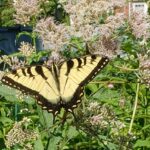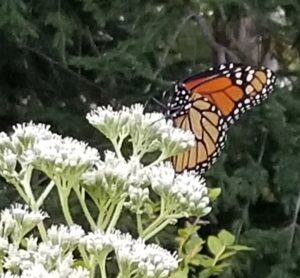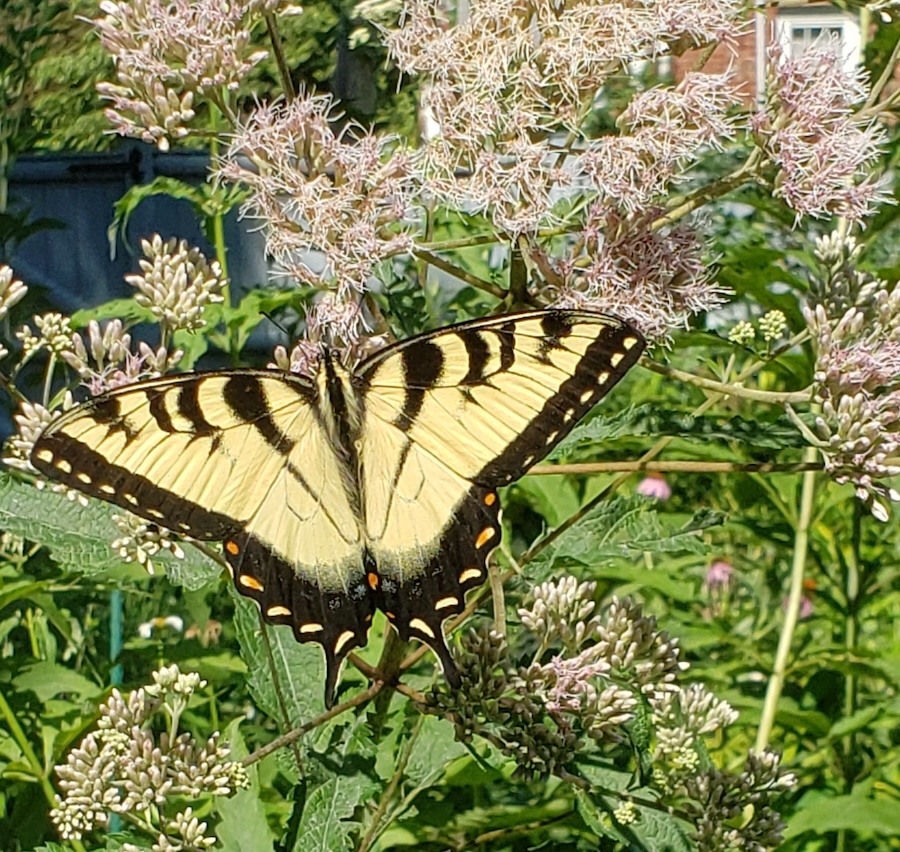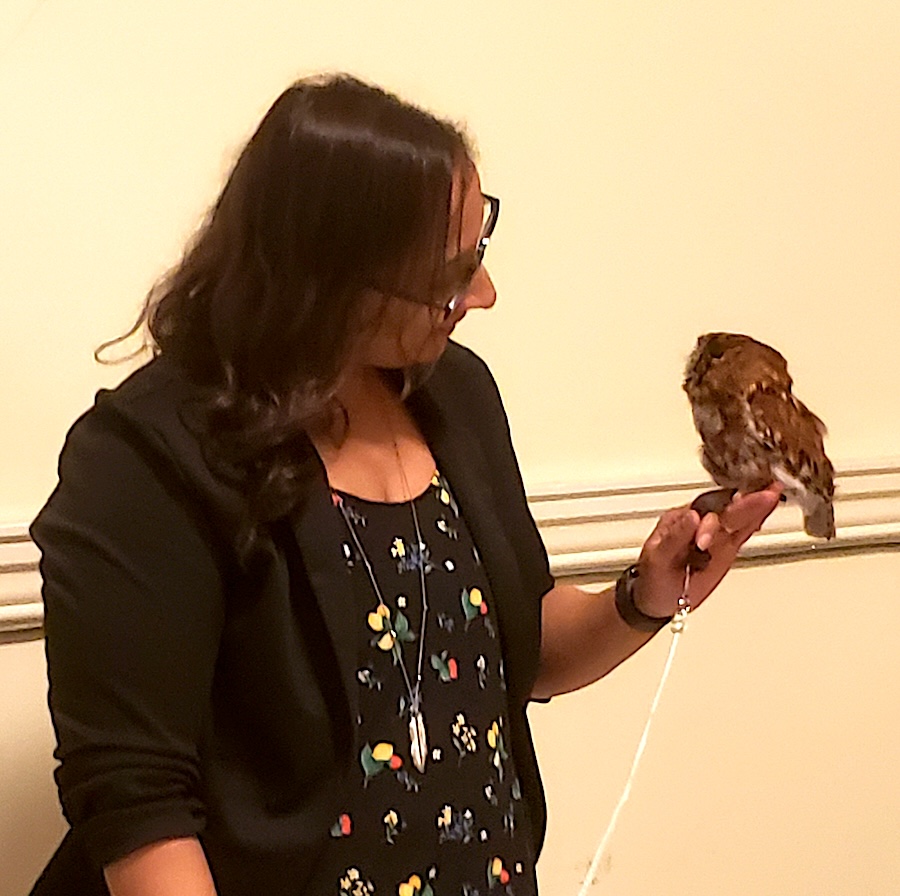
By Judy Sheldon
Whether we’re growing tidy-looking lawns, tree-lined paths to meander, or flower or vegetable gardens, our yards and our parks also provide food and shelter for other creatures.
Bees, butterflies, ladybugs, spiders, and fireflies all live in our lawns, gardens, and trees. Birds eat the seeds, berries, fruits, and nuts from the plants. Some bird species get nutrients from insects, including mosquitoes and others we don’t want around. Rabbits eat mostly plants; squirrels and chipmunks thrive on fruits, nuts, and acorns. Larger birds, like hawks, owls, and even eagles, also eat the small animals and birds that live among and feed on our plants and trees.
But what can we do if unwanted plants, insects, or mammals enter our environments? How can we manage our spaces to keep them the way we like them and support nature, yet keep out unwanted species, when everything is connected?
We can start with plants. Native plants are best suited to local weather conditions and easier to grow than non-natives. They provide more food and shelter for native creatures and are better at repelling intrusive species. Flowering pollinator plants provide nectar to feed the bees and the butterflies, which pollinate the plants they land on.
Some insects live only on specific plants. Monarch butterflies lay their eggs only on milkweed, their caterpillars’ only source of food. But a decline in the amount of milkweed has led to a drastic decline in the Monarch population. The US Fish & Wildlife Service says that a proposal to list Monarchs as threatened or endangered is “warranted but precluded by higher priority actions.”
According to Douglas W. Tallamy, author of Nature’s Best Hope, “native flowering dogwood (Cornus florida) . . . supports 117 species of moths and butterflies alone.” Commonly planted Kousa dogwoods, native to China, support none. The Belmont Shade Tree Committee has created a list of preferred trees, encouraging the DPW and Belmont residents to plant natives along streets and in yards.
Tallamy reports that oak trees support more forms of life than any other plant. In our mid-Atlantic region, oaks support 557 caterpillar species and are considered first or second in food support throughout the country. If you have a lot of room, plant an oak! Either way, plant pollinator plants, especially milkweed. Common milkweed is very aggressive, but swamp milkweed and many other varieties, with their lovely scents, are not.
Habitat loss, pesticides, and climate change are taking a toll on plants and on the wildlife they support. As our human population increases, some previously wild areas have become farms, and lands and roadsides that were covered with pollinator plants are more frequently mowed, eliminating the contiguous wild areas that many species need. The Earth’s climate is changing so that some plants that once grew in particular planting zones are not doing as well there. New varieties of crop seeds have been genetically modified to tolerate pesticides, to easily allow their use. Pesticides are often used not only on farms and roadsides, but also on people’s lawns.
Managing Plants
What can we do about unwanted plants?
First, we can appreciate some weeds. Dandelions are among the first plants to emerge in spring, so they support bees when there’s not much else around. Clover and violet flowers are pretty and also good for the pollinators.
If you don’t want these plants in your lawn, it’s easy to dig out individual plants. Unfortunately, too often, the solution is to use herbicides, many of which can cause more damage and stay around longer than intended. Some have been linked to human health issues. Glyphosates (such as Roundup) have been specifically linked to non-Hodgkin’s lymphoma and banned from many European countries. Bayer, Roundup’s manufacturer, has recently reformulated Roundup because of the huge amounts of money it has had to pay for lawsuits, and it recently lost another big one. Massachusetts is in the process of restricting glyphosate’s use.
But what happens if you find a patch of poison ivy? What happens when a large area is taken over by plants that are nearly impossible to dig out? We helped to remove Japanese knotweed on town land, but its deep roots simply break into smaller pieces, each piece becoming a new plant.
When there is no other option, the answer is to use herbicides sparingly and carefully. Individual plants can be cut close to the ground, with just the top of the remnant stalk dipped in herbicide. Restoration specialists are using this targeted approach to remove several kinds of invasives on Lone Tree Hill, as well as planting a variety of pollinator plants.
Managing Insects
What about insect pests, like mosquitoes and ticks? There are some easy answers for mosquitoes.
To keep adult mosquitoes away, use an oscillating fan at outdoor seating areas. It’s more efficient to eliminate the larvae, though. They live in water, so prevent their breeding by eliminating standing water; replace birdbath or other water sources at least once a week. You can also float mosquito dunk tablets in water. They’re made of Bti, a bacteria that kills mosquito larvae and nothing else. Again, unfortunately, too many people use insecticides on their lawns.
Most mosquito sprays aim to kill adult mosquitoes, so they require frequent, more expensive retreatment. They also kill all insects, not just mosquitoes. People are sometimes told that a bug spray is safe because it’s organic, but that’s irrelevant. A butterfly or a bee killed by a poison derived from plants is no less dead.
People rightly fear ticks; they can cause serious harm from Lyme and other diseases. But before treating for ticks, check to see if you actually have any. Ticks don’t live in lawns, but in tall grasses. You might run across them when hiking. So wear long sleeves and pants, tuck your pants into your socks, and try to avoid brushing against tall weeds. If you feel the need, you can also use an insect repellent on your clothing. After hiking, make a habit of doing a tick check. Ticks take hours to implant, so remove any before they have time.
Do you remember how car windshields used to be spattered with bugs after a long drive? That’s not the case any more. In a 2020 article, Tallamy cited “a 45% decline in insect populations in just the past 40 years.”
As insects decline, so do the birds that eat them. A recent article in the Washington Post describes a conversation with researchers from the Cornell Lab of Ornithology. The lab manages eBird, a huge database of detailed observations from a million birders around the world. You can enter the name of a town and see how its bird species have fared. Belmont’s changes range from a decrease of 68% of our American tree sparrows to 21% of house sparrows and black-capped chickadees and 19% of American robins.
It’s not all bad news. Blue jays, which will eat just about anything, have increased by 22%, downy woodpeckers by 12%, and northern cardinals by 11%. But on average, nearly 30% of the North American bird population has been lost just in the last half-century.
That 21% decline in the population of black-capped chickadees in Belmont might be partly explained by a statistic from Tallamy’s book, Nature’s Best Hope. He tells of a researcher who counted parents bringing 350 to 570 caterpillars a day during a typical 16-day nesting period. Depending on the number of chicks, that’s 6,000 to 9,000 caterpillars per clutch, plus more after the young leave the nest! Fewer butterflies and moths means fewer caterpillars, which means less bird food.
Managing Mammals
Our small mammals are usually not a problem. While rabbits can be a nuisance, eating our hostas and vegetables, careful fencing can keep them out of gardens, and they might also be dinner for a hawk—or a fox or a coyote!
We can plant other things for them to eat instead. Their favorite food is clover, which we can use instead of grass for our lawns. No clovers are native to Massachusetts, but white clover has become naturalized, and low-growing microclover needs less water and mowing than grass and grows well in partial shade. Other low-growing plants like creeping thyme, with its aromatic flowers, stand up to foot traffic and make a nice grass substitute. Rabbits dislike strong scents, so a wide variety of flowering plants deter them, or at least don’t get eaten. As a bonus, many of the flowers are good for pollinators.
Belmont has had a problem with rats, which can carry dangerous diseases. The first step is to make sure you’re not leaving food out for them. Remove dog food bowls, check compost bins, and (sob!), stop filling bird feeders and even birdbaths. According to the Humane Society, you can try to repel rats with strong-smelling herbs or peppermint oil, but the least inhumane way to kill rats is with traps. Use traps that produce an electrical charge or wood and metal snap traps. All traps must be covered with a box or a milk crate to protect birds and other animals. Glue traps cause a slow, painful death and are just cruel.
Relatively new second-generation anticoagulant rodenticides (SGARs), often placed in bait boxes, do not kill rats immediately. Instead they are meant to be taken back to the rats’ nests to kill the rest of the rat families. Unfortunately, those animals are food. Poisoned rats end up where raptors and larger mammals find and eat them, poisoning the predators too, as well as posing a threat to pets and even children. Last March, a bald eagle in Arlington died, believed to have been from ingesting rodenticides. Owls have been killed there the same way, so rats’ natural predators are incidental victims. Save Belmont Wildlife is working to raise awareness of the dangers of SGARs and to impose a ban or a restriction.
Massachusetts has several bills in the works to limit pesticides. One would allow Arlington and other towns to regulate pesticides at the town level if the state does not restrict them. Last May, we went to the State House to support passage of 10 pesticide bills. Dr. Priya Patel, a wildlife vet and the medical director at the New England Wildlife Center, held a small screech owl named Loki as she testified about the increasing difficulty of treating poisoned raptors. Care that used to take a few months can now require up to two years because of the severity of their illness from these new rodenticides.
Supporting Nature
Healthy plants help support healthy insects, both of which support healthy birds and animals. What can we do to help this natural population? Again, start with plants.
Tallamy wants to create a Homegrown National Park. He proposes that we restore biodiversity by doing things like reducing the size of our lawns, planting native plants, reducing nighttime light, planting ground covers and leaving leaf litter under trees for caterpillar pupae, and avoiding all insecticides and herbicides and most fertilizers.
Locally, the Mystic Charles Pollinator Pathways Group has a map of pollinator-friendly spots; you can add your own location to the map. The Massachusetts Pollinator Network also works to protect pollinators and reduce pesticide use and provides a lot of resources.
Other organizations also promote creating contiguous areas of native, wildlife-supporting plants. The National Wildlife Federation is working with highway departments to promote pollinator habitat; they also have a native plant finder. Many sources can help you find native plants, even plants that deter rabbits.
Homegrown National Park includes a map of the country divided into ecoregions (8.1 for us) and lists examples of keystone trees and shrubs for each, which support the most species. MassWildlife has a list of native shrubs to attract insects and birds. Xerxes Society for Invertebrate Conservation has a list of native plants for pollinators, as well as a good amount of information on conservation of pollinators and endangered species.
Finally, you can stay aware of and help promote the passage of pesticide regulations in Massachusetts. The process of making laws is very long, but some changes are winding their way through it. The Northeast Organic Farming Association’s Action Network has a list of current pesticide reform bills. You can continue to ask your representatives to support them.
There’s a lot we can do to support nature in our community. It’s up to us to decide what we want to do.
Judy Sheldon is a Belmont resident, a retired technical communicator, and a member of the Belmont Garden Club’s Conservation Committee.





Sorry, the comment form is closed at this time.